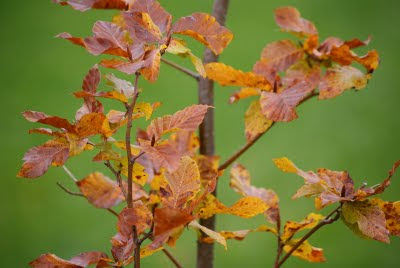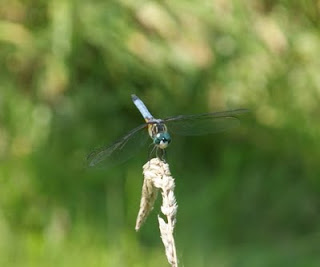meme. I have frequented Yvonne's web-site "
for a long time and when I found out about blogging (just recently), Country Gardener was my first to follow and still the one that I cannot wait to check out.
Participating in this Meme Award you have to:
Link back to the person, who gave you the award.
Reveal seven things about yourself.
Choose seven other blogs to nominate and post a link to them.
Let each of your choices know that they have been tagged by posting a comment on their blog.
When your post is up, let the tagger know.
About me:
1.
I was born in a small town,
Nykøbing Mors, in
Denmark in 1953. My parents both worked in my father's meat shop, and literally, we all lived there. The ground level apartment in a small apartment building had been divided into two: the shop and the home, so even though my mother worked full time, she was always there. In that "half" apartment my parents had day beds in the living room, and the bedroom was shared by my older brother, me, and my younger sister. There was no garden, only a small paved yard at the back where we could play. Needles to say, we were all excited when my Dad bought a house with a garden by the time that I was 12.

Most of my life was spent on the "sunshine" island
Mors, where I lived like most small town dwellers, everyone knowing everyone.
2.
Much later I met the most wonderful (Canadian) man, got married (again) and moved to Canada in 1992. Between the two of us we have four wonderful children, Ann, Alice, Dea, and Mark, who today live "all over the World": Ann in Denmark, Alice in England, Dea (with husband James) in Sweden, and Mark in Ontario, Canada. I cannot help but thinking of how difficult it must have been for families emigrating many years ago when there was no telephone, e-mail, skype, "cheap" flights etc, all factors to make it easier to live far apart.
3.
Track and field was my favourite sport when I was at school. Later I started hiking and have participitated in 100 km long international hiking events in the Alps, hiking in Germany, Switzerland, and Austria. We were more than 100 people from Denmark travelling together by buses and staying at a youth hostel in Switzerland joining the large group of international hikers. For 6 years I went on the Bodensee trip and over the years I found many wonderful friends hiking.
4.
When I was 15 I had a summer job at a nursery. I started at 6 in the morning and worked till noon collecting tulip bulbs, crawling on my knees behind a tractor that was working the soil to loosen the bulbs. I stayed at my aunt and uncle that summer and I had to ride my uncle's moped for about one hour to get to the nursery. I was so proud and spent the money on a coat and winter boots made of the softest skin.
5.
I love cooking. I never make anything, but from scratch - probably because that was how I was brought up. My mom was an excellent cook, but working full time at the meat shop didn't make time for a lot of "extra" as bred making or baking cake and cookies. Her sisters were all outstanding cooks and I watched and sometimes "helped" when I was a little girl. So to me it is nothing special to have a home cooked meal every day and I always bake my own bread. A stable is Danish rye bread which is somewhat like the German dark, dense rye bread. It is made with a sourdough, and I ad lots of rye and wheat kernels as well as pumpkin seeds. This bread is sliced very thinly, and used for open face "sandwiches" - which you may know is a Danish specialty.
6.
As a teenager I listened to Danish as well as international pop and rock. And I was an Elvis fan! Today I enjoy classic rock, easy listening and light classical music. The radio is mostly tuned in on oldies, some easy listening, or sometimes the Danish radio (the computer is hooked up to our amplifier).
7.
I also love dancing. When the work schedule has allowed we have been taking dance lessons over the last few years. When my parents had a party at the house, they would be dancing and that's where I learned my first steps of polka, waltz, cha-cha, etc. Music and dance just make me happy.
Now for my seven nominees:








 In the field '
In the field '

 The white poppy (
The white poppy ( Brazilian verbena (verbena
Brazilian verbena (verbena 
 Daisies have always been some of my favourite flowers - I would just wish that they had a much longer blooming time. I chose this double
Daisies have always been some of my favourite flowers - I would just wish that they had a much longer blooming time. I chose this double  This beautiful
This beautiful  Sitting right in the middle of the lowest spot and with their feet in water were the
Sitting right in the middle of the lowest spot and with their feet in water were the  Saved by the trench were the native Giant Blue
Saved by the trench were the native Giant Blue  Another native (you find it everywhere around the countryside this time of the year) the aster (aster
Another native (you find it everywhere around the countryside this time of the year) the aster (aster  Butterfly weed (
Butterfly weed (
 I didn't really expect any of the
I didn't really expect any of the  Most of my life was spent on the "sunshine" island
Most of my life was spent on the "sunshine" island 


 The Pickerel Weed (
The Pickerel Weed ( The flowers of Arrowhead (
The flowers of Arrowhead ( The leaves of the
The leaves of the  We have lots of frogs in and around the pond - green, brown and leopard frogs - but they usually jump into the pond as we get closer. A "frog" noise and a splash, but one day, when the water level was lower, I was lucky to get a glimpse of this guy.
We have lots of frogs in and around the pond - green, brown and leopard frogs - but they usually jump into the pond as we get closer. A "frog" noise and a splash, but one day, when the water level was lower, I was lucky to get a glimpse of this guy.


 I would have liked to capture one of the big ones flying - they are just like tiny helicopters!
I would have liked to capture one of the big ones flying - they are just like tiny helicopters!

 My harvest of 'Americana' on the other hand, was all cut up for propagation and I planted 1500 new plants.
My harvest of 'Americana' on the other hand, was all cut up for propagation and I planted 1500 new plants. I am quite happy with the new plants in the field as most are growing well. 'Americana' is not the most vigorous variety the first year - but they are not the slowest either!
I am quite happy with the new plants in the field as most are growing well. 'Americana' is not the most vigorous variety the first year - but they are not the slowest either! A shoot showing off the beautiful bluish, grey leaf colour of the 'Americana'.
A shoot showing off the beautiful bluish, grey leaf colour of the 'Americana'. The
The  Verbena
Verbena  I transplanted the first 10 of
I transplanted the first 10 of  The native Aster
The native Aster  Digitalis
Digitalis 
 Some species/varieties seem to be doing well, but stay small as this
Some species/varieties seem to be doing well, but stay small as this 

 Winter sowed
Winter sowed 

 The willows in the field are doing great. Looks like almost 100% of this year's plantings are growing well and not - so far - any signs of deer stopping by for munchies.
The willows in the field are doing great. Looks like almost 100% of this year's plantings are growing well and not - so far - any signs of deer stopping by for munchies.



